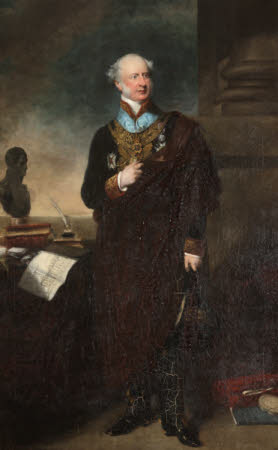General the Hon. Sir Edward Cust, 1st Bt, MP, DCL (1794-1878)
British (English) School
Category
Art / Oil paintings
Date
1840 - 1850
Materials
Oil on canvas
Measurements
2362 x 1448 mm (93 x 57 in)
Place of origin
England
Order this imageCollection
Erddig, Wrexham
NT 1151394
Summary
Oil painting on canvas. A painting of General the Hon. Sir Edward Cust, 1st Bt, MP, DCL (1794-1878), British (English) School, 1840-50. A full-length portrait of the sixth son of 1st Lord Brownlow and father of Victoria, who married Simon Yorke III in 1846, standing next to a classical column on the right, in uniform with red cloak and the Guelphic Order of Hanover. On the left is a table on which sits a bust, books, pen and ink well and a print falling over the edge. General Hon. Sir Edward Cust, 1st Bt; sixth son of 1st Lord Brownlow; created baronet 1876; lived at Leasowe Castle, Cheshire; father of Victoria Cust, who married Simon Yorke III in 1846. General, courtier, military historian, and Christian writer. He fought in the Peninsular War, but never saw active service again; when he died, he was almost the last surviving officer from it. In 1816 Prince Leopold of Saxe-Coburg appointed him his equerry, and subsequently Master of his Household, a post that he held until Leopold became King of the Belgians in 1831, retaining his confidence thereafter. Tory M.P. for Grantham 1818-26, and for Lostwithiel from then until its suppression under the Reform Bill in 1832. He took an active part in securing the principle of open competition for public architectural commissions, and became a commissioner for the rebuilding of the Houses of Parliament, and for the design of the Wellington Monument. In 1846 he was appointed Assistant Master of Ceremonies to Queen Victoria, and in 1847 Master, securing the friendship of the sovereign, and retaining the post until his retirement in 1876, when he was rewarded with a baronetcy. His military histories won him a gold medal from the Emperor Franz Joseph, whilst his ,Noctes Dominicae, or Sunday Night Readings' (1848), and ,Family Readings - the New Testament harmonised and explained' (1850) brought him an honorary D.C.L. from Oxford in 1853. His wife, Mary Anne Boode, only child of Lewis William Boode, of Amsterdam and Peover Hall, Cheshire, and heiress of her mother, Margaret Dannett of Leasowe Castle, Birkenhead, was Bedchamber-Woman to Queen Victoria's mother, the Duchess of Kent, and wrote a popular book on ,Cats'. They had one son, Leopold, named after his godfather, and four daughters, of whom Victoria was the second.
Provenance
Given by Philip Yorke III (1905 – 1978) along with the estate, house and contents to the National Trust in 1973
Credit line
Erddig, The Yorke Collection (National Trust)
Marks and inscriptions
Verso: Inscr: on paper label on stretcher [barely legible - but it may be possible, if cleaned, to make it more so] ... Col. Cust .......... by Beadl .... [?] .... [Cust became Lt. Col. in 1826, full Colonel in 1841, and Major General in 1851, thus giving terminus post and ante]
Makers and roles
British (English) School, artist
References
Steegman 1957 John Steegman, A Survey of Portraits in Welsh Houses, Vol.I: North Wales, Cardiff, 1957, p.96 "PORTRAITS AT ERDDIG, WREXHAM HON. SIR EDWARD CUST, 1st Bt. KH, of Leasowe, Cheshire, 1794-1878. General, 6th s. of 1st Baron Brownlow (see no.13); hjis daughter m. the preceding, her kinsman. Anon c.1850. WL., life-size, standing; wearing cloak over uniform with the Guelphic Order of Hanover; a table on l., with books, a bust and a print."

